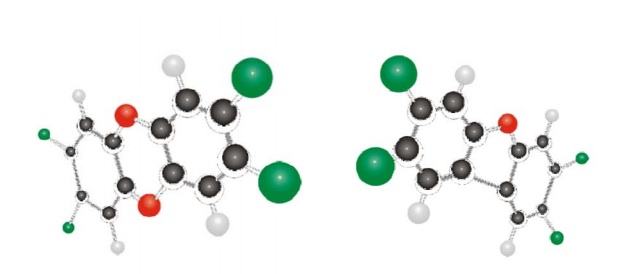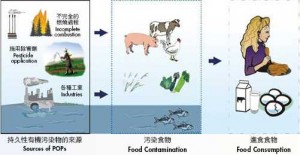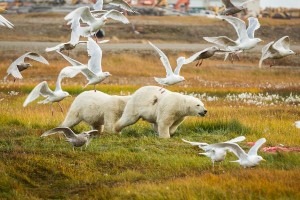What are Persistant Organic Pollutants (POPs)

What are the POPs
The Stockholm Convention on persistant organic pollutants identifies 12 substances as persistant organic pollutants or POPs, they are: Aldrin, Chlordane, DDT, Dieldrin, Dioxins, Furans, Endrin, Heptachlor, Hexachlorobenzene, Mirex, Toxaphane and Polychlorinated Biphenyls (PCBs). POPs are chemical substances having the properties:
- Produced and mobilized into the environment as a result of human activity, i.e. they are anthropogenic
- Potential to cause harm to human health and/or to the environment, i.e. do adverse effects
- Long life in the environment and not easily or quickly broken down when they are in air, in water, in soil, in sediments and/or in biota, i.e. they are persistent in environment
- Become concentrated in the environment to levels of concern under circumstances where species accumulate POPs by eating smaller POPs contaminated organisms, i.e. undergo bioaccumulation
- Travel long distances in the environment (through air, water or migratory species), and accumulate at locations that are distant from the sources of release
POPs are substances that produce very adverse effects on both the ecosystem and human health due to: i) their very high toxicity, expressed in numerous pathologies ranging from behavioral changes to malignant neoplasms; ii) their prolonged persistence in contaminated ecosystems and in individuals because of their extremely limited biodegradability and iii) their deep penetration in even the remotest areas such as the Arctic. It is very likely that the main reason why organochlorine residues, such as DDT, continue to persist in the environment and even to increase, as seen in the Arctic ecosystem, is that the worldwide use of many of these products is more widespread now than in 1970 when they were banned in the United States due to their severe impact on human health and ecosystems.
Among the persistent organic pollutants, special attention must be given to dioxin-like compounds (PCDDs and PCDFs). These substances do not exist in nature and are not intentionally produced by man but are the result of activities such as the manufacture of other substances (e.g., PCBs and chlorinated phenols), the incineration of the waste produced by cities, hospitals, and industry; toxic waste; the combustion of petroleum derivatives, etc. Due to their severe toxic effects, these substances constitute a very high risk, particularly for those who live or work near where they are produced or ultimately concentrate, and such places may be as far removed from where they are emitted as the Arctic region.
The toxicity of these substances depends on the species, sex and age of the organisms affected. Notable adverse effects include loss of bodyweight, hepatotoxicity, gastric disorders, porphyria, carcinogenesis, immunotoxic effects, and changes in development and the reproductive function and in the nervous and endocrine systems. Although the reference value in the human population has been found to be only 20 ng/kg of bodyweight (in bodyfat), it should be noted that in cases that are exceptional for the time being the level of these substances in organisms has exceeded 50 ng/kg. 1 The fact that only 1 ng/kg a day can have an adverse impact on reproduction, while concentrations ranging from 0.01 to 0.1 ug/kg of bodyweight can produce hepatocellular carcinoma gives us an idea of the toxicity of these compounds. An additional example of the diversity of toxic effects depending on the chemical structure of each substance is the case of Aroclor 1254, where the exposure of pregnant women to 25 ug/kg resulted in a 15% reduction in the birthweight of their babies, which subsequently lost more weight, while other changes were reported in the fingers and nails and in the structure of the kidney and pancreas. The toxicity of these products varies markedly by species: 0.6 mg/kg of bodyweight of TCDD represents an LD50 for a guinea-pig while a similar effect in a hamster requires 5.051mg/kg. However, it must be pointed out that the toxic effects on embryos occur with similar maternal doses regardless of species. 2
Biochemical Impacts of POPs
The biochemical effects of TCDD can be divided into three classes:
- Metabolic alterations due to enzymatic changes;
- Alterations in homeostasis resulting from changes in hormones and their receptors; and
- Alterations in growth and differentiation as a result of changes in growth factors and their receptors.
The current paradigm is that the toxic effects of the dioxin-like compounds (DLCs and TCDD) are primarily produced through the Ah receptor but other mechanisms such as binding with hormones, enzymes, and changes in the concentration of biological amines have also been reported. A working hypothesis could be that TCDDs and DLCs act as endocrine disrupters or environmental hormones; this seems to be consistent with the multiple adverse effects they produce during the perinatal period, especially in the immune, endocrine, and reproductive systems and in neurological development. Acting as hormones or endocrine disrupters, these substances may also produce neoplasia during the developmental period or in adults.
Embryonic development represents one of the most complex processes in the life cycle and is exceptionally sensitive to toxic substances. In addition, each stage depends largely on the normal completion of the previous stage. Chemical substances interfere with normal processes through mechanisms such as interactions with genetic material, with the components of cell membranes, enzymes, receptors, etc. Due to the differential susceptibility to toxic substances at the various stages of embryonic development, when exposure to these toxic substances coincides with the most sensitive periods of development, adverse effects can be exceptionally severe and may even interrupt basic vital functions, resulting in the death of the embryo, or produce sublethal effects consisting of malformations and functional alterations. It is important to point out that, as with other substance that produce teratogenic effects, all these effects occur at significantly lower concentrations than those that are toxic for the mother. On the other hand, it should be noted that the developing embryo has an exceptional ability to regulate and regenerate, as has been demonstrated, for example, in the ability of embryos affected by exposure to lead to regulate shape and to recover. For this reason, malformations or functional alterations reported in newborns should be regarded as the damage remaining from a much more compromised situation suffered by the embryo due to chemical stress, something that happened without our knowledge.
Although POPs are stored primarily in bodyfat, it is important to note that they pass through the placenta and are excreted in breast milk, increasing exposure to these substances throughout the breast-feeding period. Children, in addition to requiring more calories per kg of weight, are also at greater risk of being affected than adults, due to a lower barrier to absorption through the skin, gastrointestinal tract, and lungs. Thus, it can be estimated that children absorb approximately 100 times more of these substances than adults and also have lower levels of detoxifying enzymes.
Based on the information above, it would seem that all organisms in the ecosystem including humans have absorbed dioxin-like compounds at levels that could be assumed to represent some risk to their own health or that of their progeny. Bearing in mind the high susceptibility to toxic substances during embryonic development and the perinatal period, this report will emphasize the adverse effects of this type of compound during these periods, particularly on the nervous, reproductive, immune and endocrine systems. It will also consider the need to anticipate potential adverse effects on human health and life in general through studies based on environmental monitoring and biomarkers that will allow us to obtain information on exposure levels and adverse effects. Finally, the need to conduct studies in the MERCOSUR region assessing the risks to the ecosystem and human health associated with POPs is part of the objective of achieving sustainable development.
Effects of POPs on Human Health and Environment
The harmful effects of POPs on human health and the environment was unknown until the 1960s. As a result the use of these compounds were encouraged until the scientists have developed a large body of evidence associating POPs to do injuries to human health and to the environment. The first evidence pointed by the researcher is the population declines in wildlife due to POPs. The scientists observed a range of health injuries in birds, fishes and mammals. Wildlife species exposed to POPs in the environment may exhibit any of a number of different kinds of injury. This includes:
I. Reproduction failure and population declines;
II. Abnormal functioning of thyroids and other hormone system;
III. Feminization of males and masculization of females;
IV. Immune system becomes weaker;
V. Abnormalities in behavior;
VI. Tumors and cancer;
VII. Birth defects;



